Given number of individuals in a grass land ecosystem
Grasshopper -1500
Grass - 5842000
Wolf - 28
Birds - 215
Explain trophic level
Organisms occupy a specifi place in food chain, based on their source of food is called trophic level.
Similar Questions
Read the given passage and answer the following questions :
Food chains and the energy flow within an ecosystem provide an important understanding of contingencies and mutual dependencies of organisms. The flow chart given below, depicts the energy flow within some members of a grassland ecosystem. The grass in the below ecosystem transduces 120,000 J of sunlight and fixes it into 12,000 J of energy. It is established that 90% of the energy of one trophic level is not passed to the next trophic level. Further assume that the energy transferred from one trophic level to the next is equally shared among the different organisms at that trophic level. Based on the information given and your knowledge, answer the following questions.
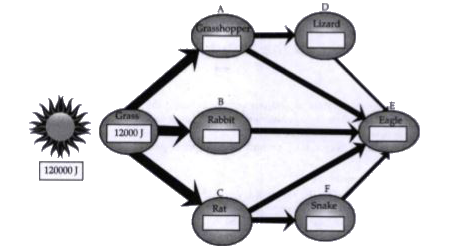
The first trophic level in a food chain is always a green plant. Why?
View SolutionGiven below is a food chain :
Grass → Grasshopper → Frog → Snake → Peacock.
What will happen to the members of different trophic levels in the food chain, if all the frogs of that area are removed ?
View Solution
Knowledge Check
Which is an example of true pyramid in an ecosystem
OR
The number of individuals at the trophic level decreases from the producer level to the consumer level inAPyramid of a biomassBPyramid of numberCPyramid of energyDNone of the aboveRead the given passage carefully and answer the questions that follow. Certain words are printed in bold to help you locate them while answering some of the these. The grassy forests of Bandipur, like many dry deciduous “forests” in south India, are not forests at all. The trees here are adapted to fire and the dry grasses fuel it frequently in the dry months between monsoons. These ecosystems are more open than closed canopy forests and the hardy vegetation found here can withstand drought conditions.
Jayashree Ratnam, associate director of the wildlife biology and conservation programme at the National Centre for Biological Science, said that these forests are mesic savannas. “Having worked for a while in African savannas and being very familiar with the idea that mixed tree-grass ecosystems were distinctive from forests, when we returned to India and started visiting various field sites, we were struck by the similarities of these sites with African savannas,” she said.
Mesic savannas receive more rainfall than some other iconic savannas of the tropics, but such ecosystems the world over are characterised by frequent burning and drought. India, however, has a blanket firesuppression policy in place and this is doing more harm than good to these tree-grass ecosystems, find a series of studies. “The more we worked and documented, the more we realised that viewing these ecosystems as forests resulted in a fundamental misunderstanding of their functional ecology, especially the roles of fire and herbivores in maintaining these ecosystems,” added Ratnam.
Savannas are ecosystems having a continuous layer of grass along with a discontinuous tree canopy. However, this structural definition of a savanna doesn’t take into consideration other biological traits of individuals and communities, which provide clues about the evolution and functional ecology of this ecosystem. Savanna trees have a number of adaptations to live in a fire-driven ecosystem. Their large underground storage organs and roots contain much of their resources and fire cannot damage these stores. Saplings re-sprout quickly and grow rapidly. Adult trees have less dense canopies than forest species, allowing more sunlight to permeate to the ground level. Mature trees also have thick bark. A 2019 study found that on average, savanna tree species from peninsular India produced twice as much bark as evergreen forest trees.
Historically, indigenous people in India used controlled burning as a way to manage their forests. The Soligas of Biligiri Rangaswamy Temple Wildlife Sanctuary, for example, would set fires early in the summer for a wide variety of reasons. Ground fires, they believe, kept hemiparasites at bay, and now, adult trees are falling prey to these organisms that depend on them in part for their survival. Soligas find that the invasive Lantana has spread, to the detriment of understorey plants and altering the structure of the forest significantly in the process. This spread of Lantana can have detrimental effects across trophic levels. “Allowing for periodic fires creates a mosaic of different densities of woody vegetation and also prevents the dominance of some weedy species such as Lantana camara. What we see now in most peninsular Indian “forests” is that fire has been totally banned and as a result Lantana has completely taken over the understorey. Since few herbivores eat the leaves of Lantana, this is going to reduce ungulate density and therefore negatively affect large carnivores such as the tiger,” said Abi T Vanak, an associate professor with the Ashoka Trust for Research in Ecology and the Environment.
Which of the these presents a contrast to the following sentence as mentioned in paragraph 6:
“Since few herbivores eat the leaves of Lantana, this is going to reduce ungulate density and therefore negatively affect large carnivores such as the tiger”ALantanas reduce food sources for carnivores.BLantanas cause habitat lossCExcess of Lantana will obstruct the field of vision of the carnivores.DHerbivores will be forced to migrate due to unavailability of food.Read the given passage carefully and answer the questions that follow. Certain words are printed in bold to help you locate them while answering some of the these.
The grassy forests of Bandipur, like many dry deciduous “forests” in south India, are not forests at all. The trees here are adapted to fire and the dry grasses fuel it frequently in the dry months between monsoons. These ecosystems are more open than closed canopy forests and the hardy vegetation found here can withstand drought conditions.
Jayashree Ratnam, associate director of the wildlife biology and conservation programme at the National Centre for Biological Science, said that these forests are mesic savannas. “Having worked for a while in African savannas and being very familiar with the idea that mixed treegrass ecosystems were distinctive from forests, when we returned to India and started visiting various field sites, we were struck by the similarities of these sites with African savannas,” she said.
Mesic savannas receive more rainfall than some other iconic savannas of the tropics, but such ecosystems the world over are characterised by frequent burning and drought. India, however, has a blanket firesuppression policy in place and this is doing more harm than good to these tree-grass ecosystems, find a series of studies. “The more we worked and documented, the more we realised that viewing these ecosystems as forests resulted in a fundamental misunderstanding of their functional ecology, especially the roles of fire and herbivores in maintaining these ecosystems,” added Ratnam.
Savannas are ecosystems having a continuous layer of grass along with a discontinuous tree canopy. However, this structural definition of a savanna doesn’t take into consideration other biological traits of individuals and communities, which provide clues about the evolution and functional ecology of this ecosystem. Savanna trees have a number of adaptations to live in a fire-driven ecosystem. Their large underground storage organs and roots contain much of their resources and fire cannot damage these stores. Saplings re-sprout quickly and grow rapidly. Adult trees have less dense canopies than forest species, allowing more sunlight to permeate to the ground level. Mature trees also have thick bark. A 2019 study found that on average, savanna tree species from peninsular India produced twice as much bark as evergreen forest trees.
Historically, indigenous people in India used controlled burning as a way to manage their forests. The Soligas of Biligiri Rangaswamy Temple Wildlife Sanctuary, for example, would set fires early in the summer for a wide variety of reasons. Ground fires, they believe, kept hemiparasites at bay, and now, adult trees are falling prey to these organisms that depend on them in part for their survival. Soligas find that the invasive Lantana has spread, to the detriment of understorey plants and altering the structure of the forest significantly in the process. This spread of Lantana can have detrimental effects across trophic levels. “Allowing for periodic fires creates a mosaic of different densities of woody vegetation and also prevents the dominance of some weedy species such as Lantana camara. What we see now in most peninsular Indian “forests” is that fire has been totally banned and as a result Lantana has completely taken over the understorey. Since few herbivores eat the leaves of Lantana, this is going to reduce ungulate density and therefore negatively affect large carnivores such as the tiger,” said Abi T Vanak, an associate professor with the Ashoka Trust for Research in Ecology and the Environment.
Which of the following is not an assumption that supports the arguments presented in the first paragraph?AForest fires usually occur where there is little to no moisture in the air.BGrassy forests are common in southern India.CDeciduous forests are immune to fire.DDeciduous trees do not obstruct the sunlight from reaching the ground.
Food chains and the energy flow within an ecosystem provide an important understanding of contingencies and mutual dependencies of organisms. The given below flow chart depicts the energy flow within some members of a grassland ecosystem. The grass in the below ecosystem transducer 120,000 J of sunlight and fixes it into 12,000 J of energy. It is established that 90% of the energy of one trophic level is not passed to the next trophic level. Further assume that the energy transferred from one trophic level to the next is equally shared among the different organisms at that trophic level.
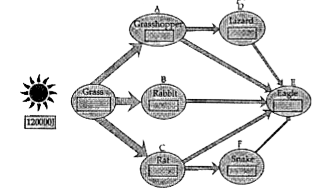
Based on the above information, indicate the amount of energy that an organism C may have received from an organism from the previous trophic level.
View SolutionFood chains and the energy flow within an ecosystem provide an important understanding of contingencies and mutual dependencies of organisms. The given below flow chart depicts the energy flow within some members of a grassland ecosystem. The grass in the below ecosystem transducer 120,000 J of sunlight and fixes it into 12,000 J of energy. It is established that 90% of the energy of one trophic level is not passed to the next trophic level. Further assume that the energy transferred from one trophic level to the next is equally shared among the different organisms at that trophic level.
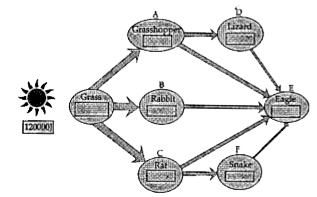
Tropic levels are formed by which of the following components?
View SolutionFood chains and the energy flow within an ecosystem provide an important understanding of contingencies and mutual dependencies of organisms. The given below flow chart depicts the energy flow within some members of a grassland ecosystem. The grass in the below ecosystem transducer 120,000 J of sunlight and fixes it into 12,000 J of energy. It is established that 90% of the energy of one trophic level is not passed to the next trophic level. Further assume that the energy transferred from one trophic level to the next is equally shared among the different organisms at that trophic level.
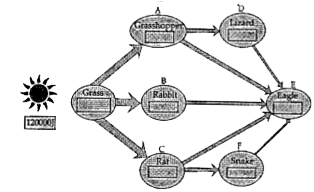
In the food web depicted above, identify the most energy efficient link for tertiary consumer.
View SolutionFood chains and the energy flow within an ecosystem provide an important understanding of contingencies and mutual dependencies of organisms. The given below flow chart depicts the energy flow within some members of a grassland ecosystem. The grass in the below ecosystem transducer 120,000 J of sunlight and fixes it into 12,000 J of energy. It is established that 90% of the energy of one trophic level is not passed to the next trophic level. Further assume that the energy transferred from one trophic level to the next is equally shared among the different organisms at that trophic level.
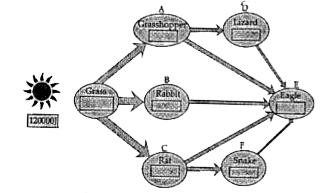
Which organism acts as both the secondary consumer and the tertiary consumer?
View SolutionFood chains and the energy flow within an ecosystem provide an important understanding of contingencies and mutual dependencies of organisms. The given below flow chart depicts the energy flow within some members of a grassland ecosystem. The grass in the below ecosystem transducer 120,000 J of sunlight and fixes it into 12,000 J of energy. It is established that 90% of the energy of one trophic level is not passed to the next trophic level. Further assume that the energy transferred from one trophic level to the next is equally shared among the different organisms at that trophic level.
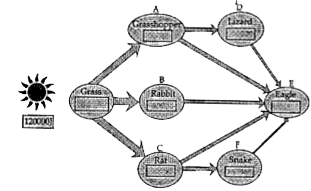
How many food chains are present in the food web depicted above?
View Solution
